Also known as
Peperomia maculosa : tequelite, tequelite macho (1), najashuio macho, juksasan, cunsasan grande, oreja de burro “donkey ear” (Coatepec, Altotonga, Coscomatepec.), cuantepeneni (Altotonga), cilantro de monte and cilantro macho (Coatepec, Xico)
P.peltilimba : Nacastequilit, tequelite, tequelite hembra (1),Tequelite de panixkaka (Cuetzalan, Zoquiapan, Tuzamapan, Huehuetla and Tlalauquitepec, in the northern highlands of Puebla (Rodríguez & al., 2010) tepoquelite, cilantro de monte, cilantro cimarrón, cilantro de monte (Coatepec, Veracruz), cilantrillo (La Sombra, Municipality of Alto Lucero), najashuio hembra (Coatepec, Veracruz), nacasguio (El Zapotal, municipality of Acajete, Veracruz), Nacasvio (Altotonga) cuksasan, cuksaan, cuc’sazan, cunsasan chico, caochasa (Huayacocotla, Veracruz), nacazgüillo, limonascagüillo, panixkaka, oreja de ratón (Coscomatepec, Veracruz; Cuetzalan, Puebla (Rodríguez & al., 2010), oreja de tejón (Baxtla, municipality of Teocelo & Coscomatepec Veracruz), oreja de burro, peso quelite (Xico, Veracruz)
- in my Post Quillquina : Porophyllum ruderale I speak of the macho and hembra classifications of quelites. Casas (etal 2016) notes that the Mixtec of La Montaña de Guerrero differentiate two varieties of quelite (in general). A masculine “macho” and a feminine “hembra”. Macho herbs (generally speaking) had thinner, harder and in some cases pubescent leaves. These plants are more bitter and fibrous in texture. They are weeded from active fields but are allowed to grow in fallow fields. Hembra herbs have wider, tender, glabrous leaves that are more palatable as a foodstuff. They are the preferred variety of the plant and will be left alone and allowed to grow in the milpa
And some of the less common family members include
P.pseudoalpina : tequelite, cilantro silvestre, cilantro grueso
P.denticularis : causasa, tequelite, oreja de ratón, cuc’sazan, cumazani
P.donaguina : quelite de vanado, tlachinquilit
P.rotundifolia : berritos, caminante, nacaskimichin
One of the most ubiquitous herbs in Mexican cuisine is that of cilantro. This herb originated (probably) in North Africa (1) and at the time it was spread to all the corners of the then known World by the Romans. Around one thousand years later it found its way to México via the Spanish. It was quickly adopted by Mexico and you can now find it, if not as an ingredient then as a garnish, in almost every savoury Mexican dish. When I was first researching cilantro like herbs I came across the Mexican Papaloquelite (See Post Pápaloquelite : Porophyllum macrocephalum ) and then, through the writings of Diana Kennedy, I met this herb, Tequelite. The varieties of peperomia best known for their cilantro like flavour (because not all of them have this quality) are P.peltilimba and P.maculosa (Vergara 2009). Newer information says that at least three other species from Veracruz are said to have this cilantro like flavour: P. vazquezii, P. campylotropa, and P. hobbitoides. (Cházaro-Basáñez etal 2012).
1 West Asia is sometimes given as the origin of cilantro. West Asia includes Armenia, Azerbaijan, Bahrain, Cyprus, Georgia, Iraq, Israel, Jordan, Kuwait, Lebanon, Oman, Palestine, Qatar, Saudi Arabia, Syria, Turkey, United Arab Emirates, and Yemen.
The genus Peperomia was published by the Spanish botanists Hipólito Ruiz and José Pavón in the year 1794 in the work Flora Peruviana et Chilensis. Peperomia is the second largest genus in the family Piperaceae, following Piper (1) and it includes approximately 1,600 taxa. Peperomia are distributed throughout tropical and subtropical regions worldwide, although the largest diversity of the genus is encountered in the Americas from southern USA to Argentina and Chile, there are also species endemic to the Andes and Amazon regions. The Mexican states of Chiapas, Oaxaca, and Veracruz contain the highest diversity of Peperomia species throughout Mexico. Almost half of the 131 Mexican species can be found distributed throughout these States.
- the Piper species contains such plants as black pepper (Piper nigrum), Hoja santa (Piper auritum) and the betel leaf (Piper betle)
There are two main varieties of tequelite. Peperomia maculosa and P.peltilimba (although P.psuedoalpinia also often crops up in the discussion). Both P.maculosa and P.peltilimba are often used to flavour soupy dishes such as beans or soups (1), and in some places the leaves (of P.maculosa) are eaten roasted as a vegetable (Coscomatepec)(Vergara 2009).
- See Xocoyoli : The Sour Quelite for a recipe using tequelite in a soupy bean dish
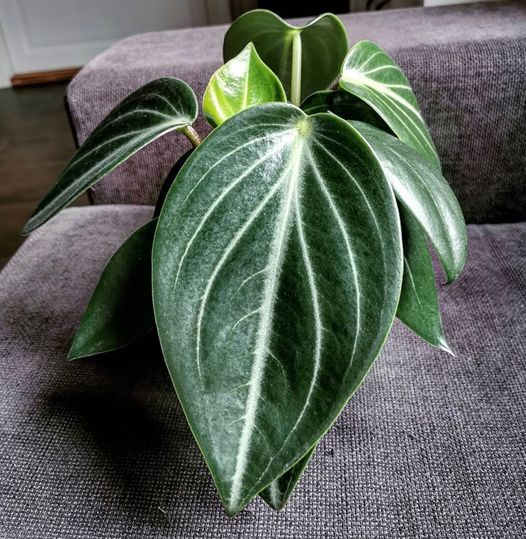
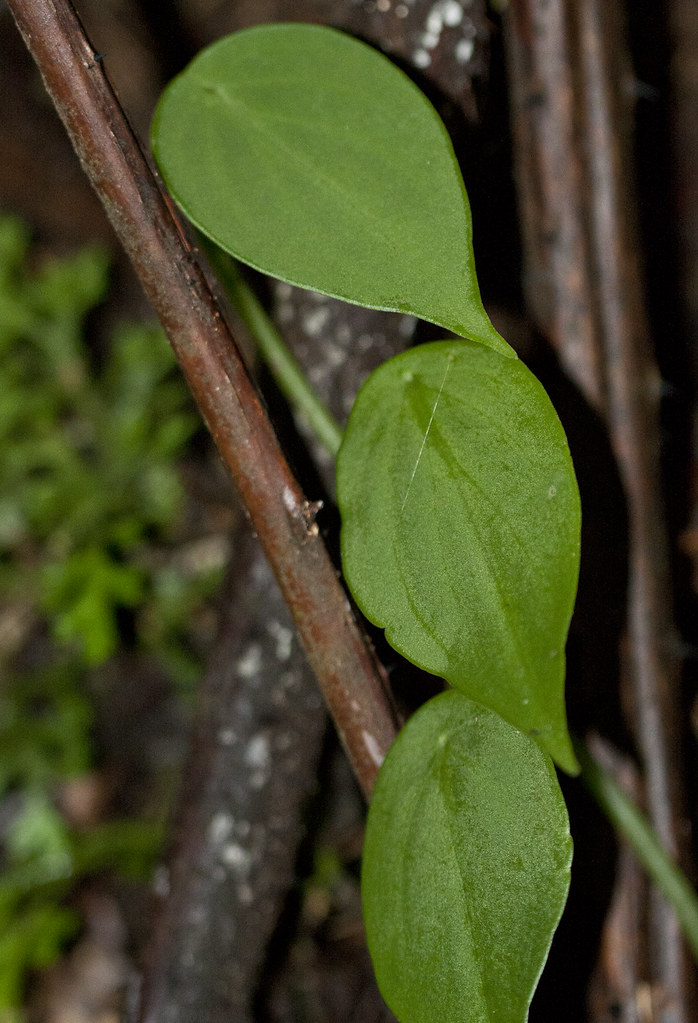
Peperomia peltilimba is a climbing, rupicolous (1) or epiphytic (2) plant (3). It grows in humid places of the mountain cloud forests of Oaxaca, Puebla and Vera Cruz. La Catrina also notes that according to the herb sellers in the mercado this species is preferred as it has a better taste and odour than P. maculosa.
- rupicolous – living among, inhabiting, or growing on rocks.
- (Vergara-Rodríguez etal 2017) : epiphytic – epiphytes, also called air plants, any plant that grows upon another plant or object merely for physical support. Epiphytes have no attachment to the ground or other obvious nutrient source and are not parasitic on the supporting plants. They draw their sustenance from the moist, humid air of the cloud forests in which they grow
- Various of the Peperomia species can also be described as saxicolous (saxicoline) : “living or growing on or among rocks”; epilithic : “(of a plant) growing on the surface of rock” (most seaweeds are epilithic) and geophytic : which is under the umbrella of “cryptophytes” (‘hidden plants’) which are those plants with buds beneath the substratum, for example, in the soil, water, or in the soil under water. Plants classified in this category are subdivided into geophytes, helophytes, and hydrophytes. Geophytes are perennial plants that have tuberous subterranean organs (leaf bases, roots, or stems) filled with stored food, (for example the potato or daffodil – and a squillion others – including various of the Oxalis species) which provides for rapid growth with the return of favourable climatic conditions (and for those interested – Helophytes are emergent marsh plants with renewal buds located beneath the soil–water interface (e.g., Typha) Hydrophytes include free-floating forms and those that are rooted but do not emerge above water level (e.g., Lemna and Potamogeton) (Fath & Jørgensen 2008)
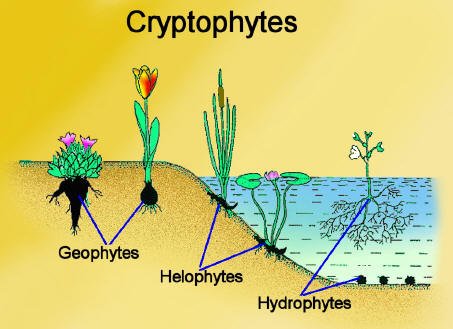



This herb is noted in my Post Xocoyoli : The Sour Quelite as an ingredient in a soupy bean dish containing other quelites. In this dish by Pueblan chef Freddy Cortés it is noted of this herb that “They are a variety of quelites from the mountains that release a special mucus that helps thicken the stews to which it is added.” The image below shows some of the ingredients in this dish including the sour stems of the quelite called xocoyoli (at the right of the image).

In the same Post (Xocoyoli : The Sour Quelite ) I have also noted a method of preparing this herb by blanching it in an alkaline liquid before consuming it. This preparation method is specific to another (potentially dangerous) quelite called mafafa (Xanthosoma robustum) as this plant contains poisonously dangerous levels of an irritant called oxalic acid which is rendered inert by this preparation method. I see no reason why tequelite needs this preparation as I have seen videos of people just munching on the fresh, raw leaf and the following recipe is possibly the simplest you can prepare. Cházaro-Basañez (etal 2017) notes that in Coscomatepec the roasted leaves are eaten as a vegetable.


In the tacos de tequelite recipe above the herb is referred to as Quelite de venado (deer herb). This is, of course, no relation to the Porophyllum (pore leaf/papalo) species many of which are also called deer herb but it is interesting that both may be substitutes for cilantro
A slightly more complex dish using tequelite is this salsa recipe from Huautla de Jiménez
Salsa de tomate con cilantro grueso (Tomato Salsa with Wild “Cilantro”)
Ingredients
- 300g tomatoes
- 1 chile canario, seeded (a small yellow chile, can be substituted with a rocoto or manzano chile)
- 1 garlic clove, peeled and finely chopped
- 6 leaves of cilantro grueso, finely chopped (substitute with cilantro)
- Salt to taste
- Finely chopped white onion (as a garnish)
Method
- Place the tomatoes and the chile into a small pot and fill with just enough water to cover them
- Simmer gently over a medium heat until both are soft, about 10 minutes.
- Put the garlic, the leaves, and salt into the blender with one of the tomatoes and blend until smooth. You could also do this in your molcajete.
- Add the chile and the rest of the tomatoes to the blender and pulse, adding some of the cooking water (if needed) to make a slightly textured salsa
- Serve with chopped onion on top
If you want to expand your repertoire then try these as well. The following recipes have been taken from the most excellent book the Recetario de quelites de la Sierra Norte de Puebla (Castro Lara etal 2005). This book demonstrates the indigenous uses of many wild and weedy plants as foods and includes images of the plants as depicted by local school children.
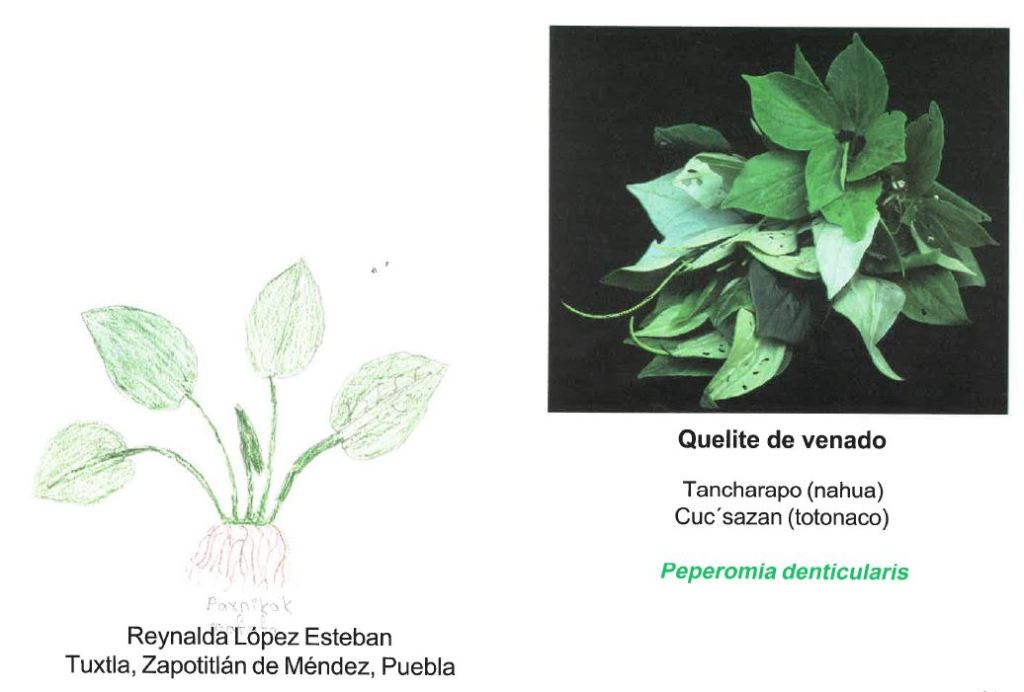
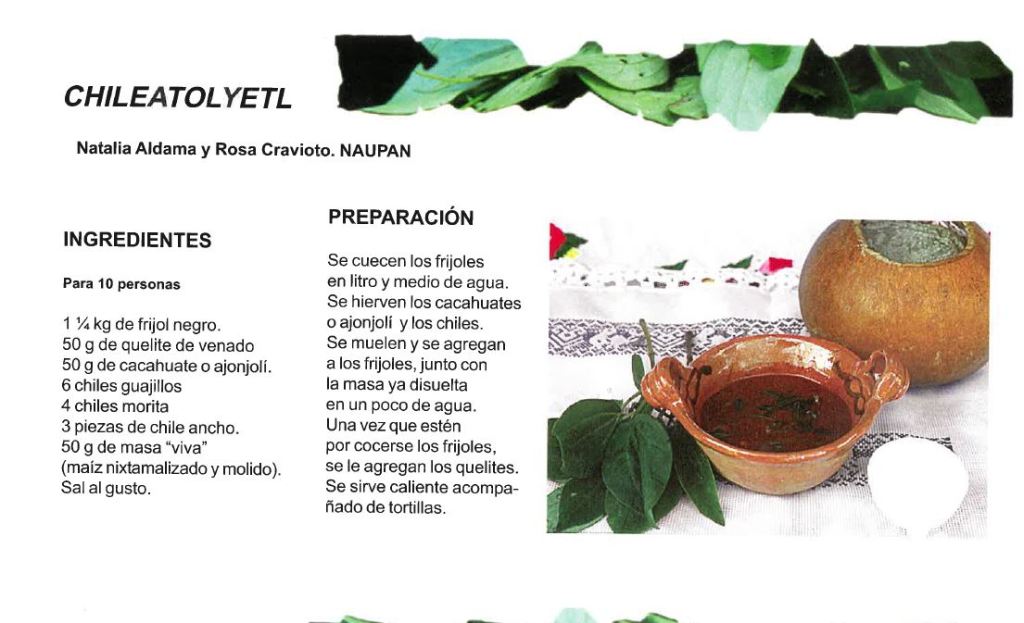
…and for those with the time….Tamales de tequelite


Find this book. It’s a beauty.


Medicinal Use.
There is not a lot of information (that I was able to garner anyway) on the medicinal usage of this herb.
Cházaro-Basañez (etal 2012) notes that P.maculos is used medicinally to treat erysipelas (1). No other information other than this given.
- A bacterial infection of the skin’s outer layers. Compared to cellulitis, another type of skin infection, erysipelas affects more surface layers of skin. Symptoms may include redness and pain at the affected site, fevers and chills. Erysipelas requires treatment with antibiotics to prevent the spread of infection. Medication for pain and fever may also be used.
According to Vergara (2009), it is known that in the state of Veracruz, the Peperomia species (in general) are used as medicinal plants for their diuretic properties.
Other varieties of the peperomia species are used medicinally. Barboza (etal 2009) makes note of the medicinal use of several members of the peperomia family in Argentina. Most of the uses mentioned involve women’s health. WARNING : these uses all involve (well nearly all) women’s health, in particular stimulating menses and stimulating childbirth. This makes it unsuitable for women in all but the final stages of pregnancy. Any herb that stimulates menstruation has the potential to cause spontaneous abortion and one species in particular has been noted as being an abortifacient. DO NOT take these herbs medicinally during the early stages of pregnancy. They are best used during labour to make the process easier (if there is such a thing) and to help expel the placenta so as to avoid potential post-partum illnesses.


References
- Andrade Cetto, Adolfo. (2009). Ethnobotanical study of the medicinal plants from Tlanchinol, Hidalgo, México. Journal of ethnopharmacology. 122. 163-71. 10.1016/j.jep.2008.12.008.
- Barboza, Gloria & Cantero, Juan & César Omar, Nuñez & Pacciaroni, Adriana & Espinar, Luis. (2009). Medicinal plants: A general review and a phytochemical and ethnopharmacological screening of the native Argentine Flora. Kurtziana. 34. 7-365.
- Casas, Alejandro & Vázquez, José & Lira, Rafael. (2016). Mexican Ethnobotany: Interactions of People and Plants in Mesoamerica. 10.1007/978-1-4614-6669-7_1.
- Castañeda-Guerrero, I., M.M. Aliphat-Fernández, L. Caso-Barrera, R. Lira-Saade y D.C. Martínez-Carrera. CONOCIMIENTO TRADICIONAL Y COMPOSICIÓN DE LOS HUERTOS FAMILIARES TOTONACAS DE CAXHUACAN, PUEBLA, MÉXICO. TRADITIONAL KNOWLEDGE AND COMPOSITION OF TOTONAC HOMEGARDENS OF CAXHUACAN, PUEBLA, MEXICO. Instituto Politécnico Nacional Núm. 49: 185-217 México. Enero 2020 DOI: 10.18387/polibotanica.49.13
- Castro Lara, Delia; Alvarado Flores, Roberto; Evangelista Oliva, Virginia. (2005) Recetario de quelites de la Sierra Norte de Puebla : Universidad Nacional Autónoma de México, Instituto de Biología, Comisión Nacional para el Conocimiento y Uso de la Biodiversidad. ISBN 9703224644,
- Cházaro-Basañez M., de J., Pascual A. B. I., Vázquez-Ramírez J., Navare-Flores H. (2012) Datos misceláneos sobre dos especies de Peperomia en los estados de Veracruz y Puebla, México [Miscellaneous data on two species of Peperomia in the states of Veracruz and Puebla, Mexico]. Boletín de la Sociedad Latinoamericana y del Caribe de Cactáceas y Otras Suculentas 9: 21–25.
- ESTEVA. G & MARIELLE, C (Editors) (2003) sin maíz no hay país; Primera edición, 2003 : Museo Nacional de Culturas Populares; Hidalgo 287, Col. Coyoacán, C.P. 04100; México, D.F. ISBN 970-35-0434-5
- Fath, Brian D & Jørgensen, Sven E (Editors) (2008) Encyclopedia of Ecology : Elsevier Science : ISBN 978-0-08-045405-4
- Piedra-Malagón EM, Sosa V, Angulo DF, Díaz-Toribio MH (2022) Edible native plants of the Gulf of Mexico Province. Biodiversity Data Journal 10: e80565. https://doi.org/10.3897/BDJ.10.e80565
- Recipe by cocinero Freddy Cortés; Puebla : https://www.animalgourmet.com/2016/05/05/cocinerastradicionales-frijoles-con-xocoyoli-de-puebla-y-garbanzos-en-amarillo-de-queretaro/
- Ruiz, Hipolito, Jose Pavon. Flora Peruviana, et Chilensis, sive, Descriptiones et icones platarum Peruvianarum, et Chilensium, secundum systema Linnaeanum digestae, cum characteribus plurium generum evulgatorum reformatisauctoribus Hippolyoto Ruiz et Josepho Pavon. Madrid: Typis Gabrielis de Sancha, 1798-1802.
- Saldívar, J. & Basurto, Franco & Bye, Robert & Lara, D. & Evangelista, V. & Mapes, Cristina & Alfaro, M. & Ovando, L. & Molina, N.. (2005). De quelites me como un taco. Ciencias.
- VERGARA, D. (2009) The genus Peperomia (Piperaceae) in Veracruz, a preliminary study. Bachelor’s thesis, Faculty of Biology, Universidad Veracruzana, Xalapa, Ver. 204 pp.
- Vergara-Rodríguez D., Krömer T. (2011) ¿Conoce usted el cilantro de monte? [Do you know the montane cilantro?]. Gaceta Universidad Veracruzana 118: 24–26
- Vergara-Rodríguez D, Mathieu G, Samain M-S, Armenta-Montero S, Krömer T. (2017) Diversity, Distribution, and Conservation Status of Peperomia (Piperaceae) in the State of Veracruz, Mexico. Tropical Conservation Science. 2017;10. doi:10.1177/1940082917702383
Websites
- http://www.cuexcomate.com/2017/09/sobre-algunos-de-los-cilantros-de-monte.html
- https://enciclovida.mx/especies/166324-peperomia-peltilimba
Image References
- Cover Image by La Catrina via Facebook
- Cryptophytes : https://www.cactus-art.biz/notebook/Dictionary/Dictionary_G/dictionary_geophyte.htm
- Geophytic Peperomia : https://succulent-plant.com/families/piperaceae.html
- Peperomia Maculosa Image via The Jungle Collective on FB
- Peperomia peltilimba Hojas detalle Image by Roberto Castro-Cortes via flickr
- Tiktok image : Orejas de León : Taken at Miahuatlán de Porfirio Díaz : Taken by César Rincón @ cesarrinconoficial

